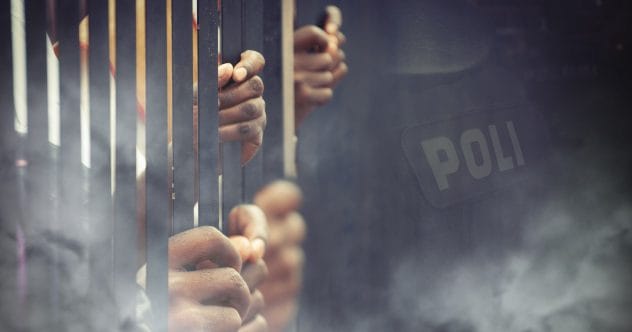Prisons aren’t exactly known for being fun, are they? Whether holding regular citizens or enemy combatants, the main focus is usually on keeping people in, not making them happy. Depending on your viewpoint, the treatment of prisoners can be seen as either justified or a violation of human rights. Sometimes, this tension explodes into full-blown riots. Let’s dive into some of the most interesting prison riots in history, ranked by their brutality, infamy, legacy, or sheer craziness.
10. A Football Massacre
The Carandiru Massacre in Brazil is a grim reminder of human rights violations. It began with a soccer match in the prison yard that turned violent. When the brawl escalated, the prison director called in the military. Soldiers locked inmates in their cells and executed them, even using attack dogs on the wounded. Tragically, Carandiru was a detention center, meaning many victims were awaiting trial, not convicts.
9. The San Quentin Six
On August 21, 1971, San Quentin inmate George Jackson received a .32 caliber pistol during a meeting with his lawyer. He used the weapon to try and escape, forcing a guard to open cell doors and sparking a riot involving over 30 inmates. The escape failed, and Jackson was among the six casualties during the chaos. The San Quentin Riot remains a stark example of desperation and failed planning.
8. Ross Perot to the Rescue
In 1979, future presidential candidate Ross Perot orchestrated a prison riot in Iran to free two of his employees. When the U.S. government wouldn’t act, Perot hired a former U.S. Special Forces colonel to extract the engineers, who were imprisoned over a contract dispute. The colonel used a large-scale prison riot as cover, smuggling the employees out of the prison and back to the United States. It’s a wild story of corporate loyalty and extreme measures.
7. Attica, of Course
The 1971 Attica Uprising is the bloodiest prison conflict in U.S. history, resulting in at least 43 deaths and over 90 injuries. Fueled by racial inequality and prisoner abuse, approximately 1,300 prisoners rioted. Although the uprising was suppressed, it led to significant reforms in the New York State prison system. The name “Attica” remains a symbol of prisoner rights and systemic issues.
6. Featherston
The Featherston Incident in New Zealand highlights the mistreatment of Japanese prisoners of war during World War II. Poor conditions and understaffing at the POW camps often led to unrest. The Featherston Incident began with a sit-down strike protesting forced labor. Within a minute, the situation escalated, resulting in 49 deaths and nearly 100 injuries. It’s a tragic example of how cultural differences and inadequate resources could lead to disaster.
5. The Cowra Breakout
The Cowra Breakout in Australia, involving Japanese prisoners of war, stands as the war’s largest prison escape and one of its bloodiest. Over 1,100 prisoners set buildings on fire, attacked guards with makeshift weapons, and tore down fences. The breakout led to 235 deaths and hundreds of successful escapees, though only briefly. Both Featherston and Cowra are often attributed to cultural clashes between the Japanese and their captors.
4. The Kengir Uprising
During Stalin’s reign, Soviet gulags were notorious for human rights abuses. The Kengir Uprising was the most significant rebellion in these forced-labor prisons. After years of abuse, prisoners seized the entire compound for 40 days. They created a semblance of paradise, merging men’s and women’s compounds, opening businesses, forming a government, and even staging plays. It was a brief, remarkable act of resistance in a brutal environment.
3. No TB Tests!
The 1993 riot at the Southern Ohio Correctional Facility (Lucasville) was unique. The riot, lasting 11 days, resulted in 10 deaths and an unlikely alliance between the Aryan Brotherhood, Black Muslims, and the Gangster Disciples. While most sought better living conditions, the Black Muslims protested forced tuberculosis testing, which they believed violated the Quran. This riot showcases the diverse motivations behind prison uprisings.
2. Strangeways Tells the Story
The 1990 riot at Strangeways Prison in Manchester, England, led to landmark prison reform. Triggered by “intolerable” conditions, including starvation, abuse, and forced sedation, the 25-day riot involved a rooftop protest that gained widespread media attention. Inspired by Strangeways, other British prisons launched their own demonstrations, leading to a public inquiry and widespread reforms in the British prison system.
1. The Warsaw Ghetto Uprising
The Warsaw Ghetto, though not a prison in the traditional sense, forcibly detained hundreds of thousands of Jews during World War II. The Warsaw Ghetto Uprising saw around 1,000 Jewish resistance fighters, along with thousands of citizens, fighting Nazi troops to prevent further deportations. Despite being outnumbered, they managed some symbolic victories. Nazi soldiers systematically burned the ghetto, resulting in tens of thousands of casualties. Their goal, as stated by a resistance leader, was to control their own deaths.
These prison riots and revolutions each tell a story of desperation, resistance, and the human spirit’s will to fight for dignity in the face of oppression. From football fields to ghetto walls, these events have left lasting impacts on history and prison reform.
What do you think about these events? Leave your comment below!










